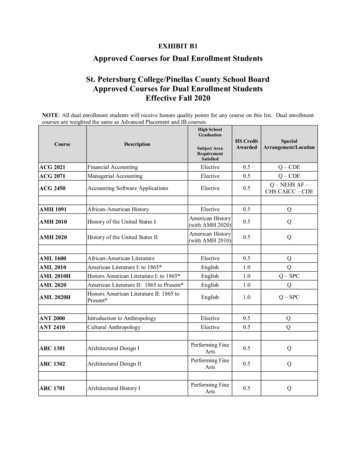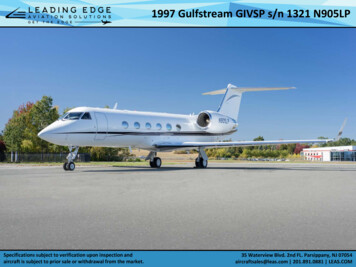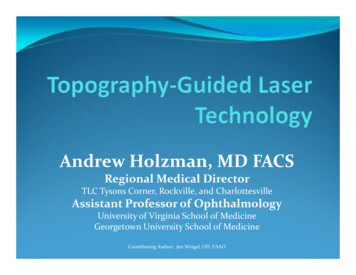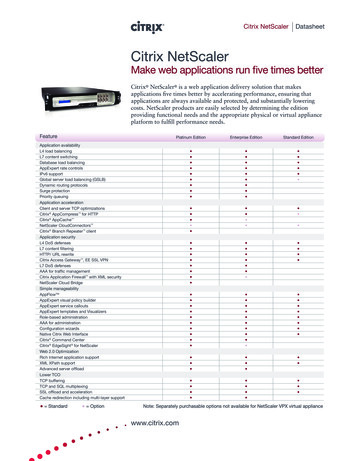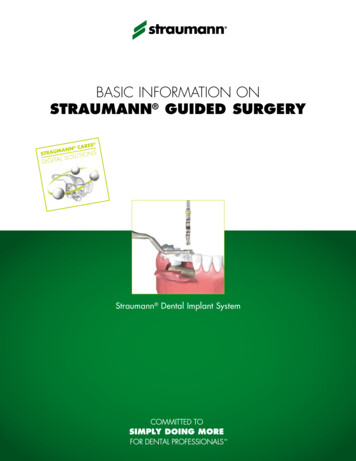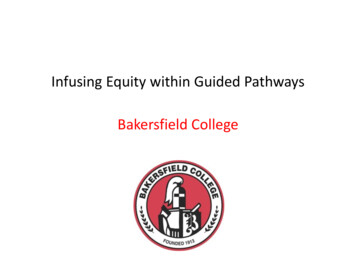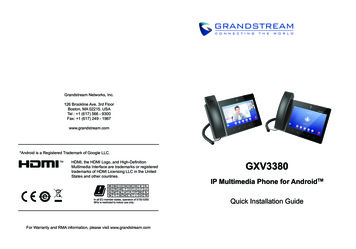Transcription
Pixel-Guided Dual-Branch Attention Network for Joint Image Deblurring andSuper-ResolutionSi Xi1Jia Wei1Weidong ZhangNetease Games AI Lab, Hangzhou, Chinaxisi789@126.com, wzwrwj@163.com, zagwin@gmail.comFigure 1. We train the Pixel-Guided Dual-Branch Attention Network for super-resolution and deblurring, successfully restore fine details.The left image is input, and the right one is output.AbstractImage deblurring and super-resolution (SR) are computer vision tasks aiming to restore image detail and spatialscale, respectively. Besides, only a few recent works of literature contribute to this task, as conventional methods dealwith SR or deblurring separately. We focus on designing anovel Pixel-Guided dual-branch attention network (PDAN)that handles both tasks jointly to address this issue. Then,we propose a novel loss function better focus on large andmedium range errors. Extensive experiments demonstratedthat the proposed PDAN with the novel loss function notonly generates remarkably clear HR images and achievescompelling results for joint image deblurring and SR tasks.In addition, our method achieves second place in NTIRE2021 Challenge on track 1 of the Image Deblurring Challenge.1 These authors contributed equally to this work and should be considered co-first authors.1. IntroductionDeep Neural Network (DNN) has promoted many practical applications, including image classification, video understanding, and many other applications. Recently, Image deblurring and super-resolution (SR) [12] have becomeimportant tasks that aim at recovering a sharp latent imagewith more detailed information and finer picture quality.Real-world blurs typically have unknown blur kernels,and the downsampling function from HR to LR is uncertain[8, 5]. Image deblurring and SR are challenging than Imageinterpolation. Although significant progress has been maderecently based on Deep Neural Network techniques, it isstill an open problem.Previous works developed which solely focus on deblurring or SR [22, 3]. However, the tasks of image deblurring and SR are highly correlated. Firstly, the feature information can be shared between them. In addition, thesetwo tasks can complement each other: better deblurring improves SR sharpness, and the SR information can refine deblurring results vice versa.Therefore, we propose a new network with the dualbranches architecture to solve image deblurring and superresolution. The pixel-guided hard example mining loss fo-
LRRCANDRNHowever, most conventional algorithms mainly focuson how to solve the motion blur caused by the movement of simple target objects, camera translation, rotation,and other factors. Simultaneously, the blurry images ofreal dynamic scenes suffer from complex and uneven blurdegradation. Therefore, traditional methods are difficult tosolve the problem of non-uniform blur in real scenes effectively. They usually involve iteration, which leads to timeconsuming and limited performance.2.2. Image Super ResolutionEDSROursFigure 2. Visualization comparison among RCAN, EDSR, DRN,and our method.cuses on the hard pixel. And auto-focusing evaluation functions are used to ensembles, different models. In the experiments section, our method generates high-resolution resultswith clear details, especially in NTIRE 2021 Image Deblurring Track 1 [13]. Low Resolution, Our method ranks second in the resulting PSNR measurement. (see Figure 2)2. Related WorkImage deblurring and image super-resolution have beenthe topic of extensive research in the past several decades.In this section, we will present the early approaches to solveimage deblurring and image super-resolution and somemethods to solve the two tasks jointly.2.1. Image DeblurringThe complex, uneven blur is caused by camera shake,depth changes, object movement, and defocusing, making ita difficult task in computer vision. Conventional deblurringmethods[17, 19, 6] focus on estimating the blur kernel corresponding to each pixel, which is a severe ill-conditionedproblem. They usually make some assumptions about theblur kernel. Methods[1, 23] uses a simple parametric priormodel to estimate the local linear blur kernel quickly.Early learning-based methods [4, 26] mainly use a convolutional neural network to estimate the unknown blur kernel to improve the accuracy of blind recovery, and thenuse the conventional deconvolution method to recover theblurred image.Recently, some end-to-end deep learning-based imagedeblurring algorithms [15, 7, 8] have been proposed, inspired by research work, such as image transmission basedon Generative Adversarial Network (GAN) [9]. Experimental results show that, compared with conventional methods,these methods have achieved good results in subjective andobjective quality.Image SR focuses on recovering HR images from LR images. In order to solve the task of image super-resolution,many methods have been proposed in the computer vision field. Over the years, the powerful capability of convolutional neural networks can significantly improve SRtasks. The basic idea of those kinds of approaches is toextract features from the original LR images and increasing the spatial resolution at the end of the network. Byremoving unnecessary modules in the traditional residualnetwork, Lim et al.[11] proposed EDSR and MDSR, andthey have made significant improvement. Furthermore, inRCAN[29], attention-based learning was used in combination with residual learning, L1 pixel loss function, and subpixel upsampling method to achieve the state-of-the-art results in image SR.2.3. Multi-Branch Network in Image RestorationTaskIn many deep learning-based algorithms, the multibranch network architecture has been widely used, andsome image restoration attempts have also been made. Different branches are usually designed as different architectures for specific tasks. Li et al.[10] proposed a deepguided network for image deblurring tasks, including image deblurring branches and scene depth feature extractionbranches. The scene depth feature extraction branch guidesthe deblurring image branch to restore a clear image. Theimage restoration task usually contains two parts of information, that is, the image structure and details. Pan et al.[16] combining these functions, proposed a parallel convolutional neural network for image restoration tasks. The network includes two parallel branches to estimate the imagestructure and detailed information and restore them in anend-to-end manner. Therefore, combining certain featuresof the image itself can help improve the quality of restoration.From the point of view of signal processing, global uniform blur is linear movement invariant processing. In a local non-uniform blur, the blur kernel will change with respect to the spatial position. Therefore, different networkmechanisms should be considered to handle the two typesof ambiguity separately.
Figure 3. The pipeline of our pixel-guided dual-branch attention network.Since the input image is extremely blurry and low resolution, the joint problem is more challenging than the individual problem. Recently, some algorithms [2, 18, 25]recover HR images from LR and blurred video sequencesbased on the neighboring information of the video. However, these kinds of algorithms cannot be applied to the casewhere a single image is used as input. Zhang et al. [28] focused on solving LR images degraded by uniform gaussianblur. Zhang et al. [27] adopt gated fusion network usingdual-branch design.3. Proposed MethodThis section introduces the entire network architectureand then defines the loss function we proposed to optimizethe model better. We will finally show our optimizationscheme.3.1. Network ArchitectureThe framework of our network is shown in Figure 3. Ournetwork takes a single blurred LR image Lblur as input, andthe network can better restore clear HR images Hsharp . According to the competition requirements, the spatial resolution of Lsharp is 4x larger than Lblur .Lblur Fblurry (Hsharp ) s(1)First, the network extracts the blurry LR features ofthe input. Our pixel-guided dual-branch attention network(PDAN) consists of three major modules: (i) a feature extraction module to blurry blur and LR features, (ii) a deblurring module to predict a sharp LR image, (iii) a reconstruction module to reconstruct the final sharp HR output image.Residual Spatial and Channel Attention Module. Recently, in many deep neural networks, the application ofthe channel attention module to improve the performanceof the network has proven to be very effective. However,the channel attention layer in Residual Channel AttentionNetwork(RCAN) [29] is too simple to achieve better performance. Here, we proposed a novel module for the betterextracting feature of blurry LR image.Inspired by the successful case of residual blocks in [11],we propose residual spatial and channel attention module(RSCA) (see Figure 4). We are more focused on extracting information features better by fusing cross-channel andspatial information.Deblurring Module. This module aims to restore asharp LR image from the blurry LR features extracted by
Figure 4. Residual Spatial and Channel Attention module. (RSCA)Figure 5. Deblurring module.the previous module. In order to enlarge the receptive fieldof the deblurring module, we adopted a residual encoderdecoder architecture. First, the encoder aims to downsample the feature map twice. Each downsampling usesa ResBlocks, followed by a stride convolutional layer withLeakyReLU. The decoder aims to increase the spatial resolution of the feature map and is completed by two deconvolution layers. Finally, two additional residual blocks areused to reconstruct a sharp LR image Lsharp (see Figure 5).As described in Section 2, there is a lot of abundant information in the blurry and LR images. The deblurring moduleaims to recover more useful deblurring information. Theabundant deblurring features can be learned through dualbranch architecture. In the test phase, the deblurring module is not used for computational efficiency.Reconstruction Module. The shallow feature from ourfeature extraction module is fed into convolutional layersand pixel-shuffling layers [20] to increase the spatial resolution by 4x. Then reconstruct the upscaled features through aconv layer to further reconstruct the HR output image. Withdual-branch attention architecture, more abundant deblurring and SR information are easier learned in the trainingprocess.Based on the dual-branch attention architecture andRSCA module, we can better address the joint image deblurring and SR tasks. We construct a very deep DAN optimized with the novel loss function shown in Section 3.2and achieves notable performance improvements.3.2. Loss FunctionGiven a training image Lblur and a network Φ, we can′. Similarly, we forpredict the final sharp HR image Hsharp′malize this process as Hsharp Φ(Lblur ). The loss is defined as:′Loss(Hsharp , Hsharp) h wXf (hi , h′i )(2)i 1where Hsharp is the ground-truth clear HR images, ingeneral, for f (x) in the above equation, the L1 function hasbeen used for perceptual SR. The L1 loss function is definedas L1(x) x , which meant the magnitude of the gradientis the same for all the points, but larger errors disproportionately influence the step size.For joint image deblurring and SR tasks, the blurry image is generated by merging subsequent frames. We found
Figure 6. Data generation process.that many fixed objects are clear, and only part of the object motion caused the blur phenomenon. (see Figure 7).Therefore, in our training images Lblur , each pixel’s composition is not uniform. Some pixels are generated througha large amount of blur and LR, while other pixels may onlybe generated through LR. When compounding the contributions from multiple pixels, the gradient will be dominatedby small errors, but the step size by larger errors. This willcause the L1 loss function to be unable to optimize eachpixel effectively.Therefore, we need to balance large errors and small errors better to optimize the network. To solve this problem,inspired by [24, 21], first we use the L1 loss function training model from scratch. We further use a hard examplemining strategy to adaptively focus more on the difficultpixels, thus encouraging the model to restore image detailand spatial scale, which is called Hard Pixel Example Mining loss (HPEM). Specifically, we calculate the error of allpixels and sort all pixels in descending order, and then setthe top p percent of pixels as hard samples according to thesorting. Finally we increase their losses through the weightw to force the model to pay more attention to hard pixels.Similarly, we formalize this process as:LossHard h wXMihard · (si s′i )1(3)iwhere M hard is the binary mask which mean the hardpixels. We fix p as 50% and w as 2. The total loss functionis the weighted sum of the following two losses:LossBlurry,LR L1 w LossHard(4)3.3. Optimization SchemeThe proposed pixel-guided dual-branch attention network contains two parallel branches, which solve image deblurring and image super-resolution, respectively. To better optimize the model, the training process is divided intothree phases: Train the dual-branch attention network with the REalistic and Dynamic Scenes dataset (REDS [12]) the L1loss function.
odelsbaselineX27.61model 1XXmodel 2XXX27.6827.84model 3XXXX27.89Table 1. Ablation study. This table reports the average PSNR obtained by different methods of our model on the REDS validation data set. Fine-tune the pixel-guided dual-branch attention network with the REDS [12] dataset and the novel lossfunction LossBlurry,LR . Fine-tune the pixel-guided dual-branch attention network with the REDS [12] and extra dataset generatedby us, and use LossBlurry,LR to optimize the model.4. ExperimentsIn this section, we first introduce experiment datasets,make a qualitative and quantitative comparison with existing approaches, and finally discuss the influence of our design on the model.4.1. DatasetFor training, we use REDS [12] dataset, which contains24,000 training images. It includes a variety of scenes andcan be used for SR and deblurring. We randomly croppatches of size 256 256 from the training Hsharp images and corresponding crop 64 64 size patches from thetraining Lblur images. Rotation and flip are applied to augment the training data. The validation set contains 3000images with corresponding ground truth. Therefore, metrics can be calculated by ground truth. The reference imageof the deblurring branch is obtained by downsampling highresolution images.4.2. Synthesizing External DatasetAs shown in Figure 6, we synthesize 72,000 externalblurry LR images through the following three steps: Frame Interpolation: We used the REDS 120fps [12]to obtain the extra data. A higher frame rate can getsmoother blurred images. We first increase the framerate by inter-frame interpolation. And use open-sourceframe interpolation methods [14] to create intermediate frames. In this way, we increased the virtual framerate to 1920 fps. Blur Synthesis: We average 1920 fps images in thesignal space and get 24 fps blurred images. Downscale: We use the MATLAB function to downsample images.Options# Parameters# FlopsDual-BranchLoss 27.61PDAN(ours)61M3.669TYesL1 HPEM0.779827.89Table 2. Quantitative results on the REDS validation dataset compared with EDSR, DRN, and RCAN. * indicates that the patch sizeis 256 256.4.3. Implementation DetailsDuring the training, we performed a lot of data enhancement, such as rotation, mirroring, brightness. The size ofthe input patches is set to 256 256. L1 loss and hard pixelexample mining loss we proposed were used and improvedPSNR and SSIM.We implement the proposed network with the PyTorch1.7 framework and using eight Tesla V100 running for distributed training. Use the ADAM optimizer for training andset the initial learning rate to 10 4 . When the loss stagnated300,000 iterations, the learning rate drops by 50 percent.The batch size is set to 128.We feed a full-size RGB image (with a typical resolutionof 320 180) into the model to obtain a high-resolutionimage. The model takes 1.7 seconds per image during inference to joint deblur and SR a 1280-by-720 pixels image.Evaluation Metric: We use PSNR, SSIM, and LPIPS asevaluation indicators. PSNR and SSIM pay more attentionto fidelity, and LPIPS focuses on visual quality.4.4. Evaluation on REDS and Ablation StudyOur proposed method aims to solve joint image deblurring and SR tasks, so we evaluate PDAN on the REDSdataset. As shown in Table 2 and Figure 7, our PDANachieves the best PSNR performance, indicating our resultscan better deal with image deblurring and super-resolutiontasks at the same time. Since we have adopted the dualbranch attention architecture, PDAN has more parameters(61 M) than EDSR (43 M) and RCAN (15.5M), which canachieve better performance in joint image deblurring andSR tasks.
LRDRNEDSRRCANOursGTFigure 7. Qualitative results with other methods on the REDS test sets. DRN and EDSR models have limitations in restoring blurry andsharpness. RCAN achieves better results than DRN and EDSR, but sometimes the edges of objects are not sharp enough and accompaniedby artifacts. Our method enhances image details by focusing on difficult pixels.
Finally, we do ablation experiments on the REDSdataset. As shown in Table 1, this table reports the PSNRimprovement obtained through different modifications. Ourbaseline only adopts RCAN, which the patch size is set to256. The number of filters in each layer is set to 128. Next,we employ residual spatial and channel attention modules toextract better blurry LR images’ features (Model 1), whichachieves 0.07dB performance improvement. We also adopta dual-branch attention architecture and fuse the intensitylevel features, achieving an improvement of 0.16dB (Model2). Finally, with our proposed loss, model 3 is 0.05dB betterthan Model 2, demonstrating the effectiveness of our attention dual-branch attention architecture and loss function.4.5. NTIRE 2021 Challenge on Image DeblurringOur method is the second place of NTIRE 2021 Challenge on track 1 Low Resolution of Image Deblurring Challenge [13]. The task of deblurring is based on a set of continuous frames of sharp video using an upsampling factor ofx4. The goal of the challenge is to obtain a solution that canrestore sharp results with the best fidelity (PSNR, SSIM) tothe ground truth.We applied the proposed method training with an extra dataset and achieved the second place results on track1 as shown in Table 3. Note that we also applied geometric self-ensemble to improve performance. Then, we ensemble three models on the REDS test dataset with a novelmethod. Divide the image into 16 patches and calculateeach area’s sharpness using the auto-focusing evaluationfunctions without reference image. Perform a weighted average of the corresponding patches according to the sharpness to get the final image. This results in clearer areas being weighted higher, improving the overall accuracy of theimage. Finally, we achieved 28.91dB, which outperforms3rd approaches by a large margin ( 0.4dB).5. ConclusionsThis paper proposes a pixel-guided dual-branch attentionnetwork with hard pixel example mining loss (PDAN) torestore potential high-resolution images from blurred lowresolution images. PDAN uses two branches to extract thelatent features effectively. Through a phased training strategy, the network learns to analyze blurry and low-resolutionfeatures. The residual spatial and channel attention module is used to extract features from inputs efficiently. Theexperimental results show that our method significantly improved the subjective and objective performances for jointimage deblurring and SR tasks compared with the existingmethods. Furthermore, our method is also the second placeof NTIRE 2021 Challenge on track 1 Low Resolution ofImage Deblurring Challenge. gination (nju)Noah CVlabTeamInceptionZOCS APExpasoft teamTrack 828.2528.2128.1127.8727.7827.6427.6127.5527.44Low ResolutionSSIMLPIPS0.8416 0.23970.8246 0.25690.8172 0.25470.8158 0.25310.8135 0.27040.8132 0.26850.8130.26660.8132 0.26060.8110.26510.8108 0.26360.8109 0.26460.8064 0.27340.8009 0.2830.7968 0.2830.7956 0.2730.7936 0.28850.7935 0.27850.7902 0.285Rank123456789101112131415161718Table 3. NTIRE 2021 Image Deblurring Challenge results onREDS test dataset. The scores were provided in [13]References[1] S Derin Babacan, Rafael Molina, Minh N Do, and Aggelos K Katsaggelos. Bayesian blind deconvolution with general sparse image priors. In European conference on computer vision, pages 341–355. Springer, 2012. 2[2] Benedicte Bascle, Andrew Blake, and Andrew Zisserman.Motion deblurring and super-resolution from an image sequence. In European conference on computer vision, pages571–582. Springer, 1996. 3[3] D. Chao, C. L. Chen, K. He, and X. Tang. Learning a deepconvolutional network for image super-resolution. In European Conference on Computer Vision, 2014. 1[4] Dong Gong, Jie Yang, Lingqiao Liu, Yanning Zhang, IanReid, Chunhua Shen, Anton Van Den Hengel, and QinfengShi. From motion blur to motion flow: A deep learning solution for removing heterogeneous motion blur. In Proceedings of the IEEE conference on computer vision and patternrecognition, pages 2319–2328, 2017. 2[5] Y. Guo, J. Chen, J. Wang, Q. Chen, J. Cao, Z. Deng, Y. Xu,and M. Tan. Closed-loop matters: Dual regression networksfor single image super-resolution. IEEE, 2020. 1[6] Adam Kaufman and Raanan Fattal. Deblurring usinganalysis-synthesis networks pair. In Proceedings of theIEEE/CVF Conference on Computer Vision and PatternRecognition, pages 5811–5820, 2020. 2[7] Orest Kupyn, Volodymyr Budzan, Mykola Mykhailych,Dmytro Mishkin, and Jiřı́ Matas. Deblurgan: Blind motion deblurring using conditional adversarial networks. InProceedings of the IEEE conference on computer vision andpattern recognition, pages 8183–8192, 2018. 2[8] Orest Kupyn, Tetiana Martyniuk, Junru Wu, and ZhangyangWang. Deblurgan-v2: Deblurring (orders-of-magnitude)
ter and better. In Proceedings of the IEEE/CVF International Conference on Computer Vision, pages 8878–8887,2019. 1, 2Christian Ledig, Lucas Theis, Ferenc Huszár, Jose Caballero,Andrew Cunningham, Alejandro Acosta, Andrew Aitken,Alykhan Tejani, Johannes Totz, Zehan Wang, et al. Photorealistic single image super-resolution using a generative adversarial network. In Proceedings of the IEEE conference oncomputer vision and pattern recognition, pages 4681–4690,2017. 2Lerenhan Li, Jinshan Pan, Wei-Sheng Lai, Changxin Gao,Nong Sang, and Ming-Hsuan Yang. Dynamic scene deblurring by depth guided model. IEEE Transactions on ImageProcessing, 29:5273–5288, 2020. 2Bee Lim, Sanghyun Son, Heewon Kim, Seungjun Nah, andKyoung Mu Lee. Enhanced deep residual networks for singleimage super-resolution. In Proceedings of the IEEE conference on computer vision and pattern recognition workshops,pages 136–144, 2017. 2, 3Seungjun Nah, Sungyong Baik, Seokil Hong, GyeongsikMoon, Sanghyun Son, Radu Timofte, and Kyoung MuLee. Ntire 2019 challenge on video deblurring and superresolution: Dataset and study. In The IEEE Conferenceon Computer Vision and Pattern Recognition (CVPR) Workshops, June 2019. 1, 5, 6Seungjun Nah, Sanghyun Son, Suyoung Lee, Radu Timofte,Kyoung Mu Lee, et al. NTIRE 2021 challenge on imagedeblurring. In IEEE/CVF Conference on Computer Visionand Pattern Recognition Workshops, 2021. 2, 8Simon Niklaus, Long Mai, and Feng Liu. Video frame interpolation via adaptive separable convolution. In Proceedingsof the IEEE International Conference on Computer Vision,pages 261–270, 2017. 6Mehdi Noroozi, Paramanand Chandramouli, and PaoloFavaro. Motion deblurring in the wild. In German conference on pattern recognition, pages 65–77. Springer, 2017.2Jinshan Pan, Sifei Liu, Deqing Sun, Jiawei Zhang, Yang Liu,Jimmy Ren, Zechao Li, Jinhui Tang, Huchuan Lu, Yu-WingTai, et al. Learning dual convolutional neural networks forlow-level vision. In Proceedings of the IEEE conference oncomputer vision and pattern recognition, pages 3070–3079,2018. 2Jinshan Pan, Deqing Sun, Hanspeter Pfister, and MingHsuan Yang. Blind image deblurring using dark channelprior. In Proceedings of the IEEE Conference on ComputerVision and Pattern Recognition, pages 1628–1636, 2016. 2Haesol Park and Kyoung Mu Lee. Joint estimation of camerapose, depth, deblurring, and super-resolution from a blurredimage sequence. In Proceedings of the IEEE InternationalConference on Computer Vision, pages 4613–4621, 2017. 3Uwe Schmidt, Carsten Rother, Sebastian Nowozin, JeremyJancsary, and Stefan Roth. Discriminative non-blind deblurring. In Proceedings of the IEEE Conference on ComputerVision and Pattern Recognition, pages 604–611, 2013. 2Wenzhe Shi, Jose Caballero, Ferenc Huszár, Johannes Totz,Andrew P Aitken, Rob Bishop, Daniel Rueckert, and Zehan[21][22][23][24][25][26][27][28][29]Wang. Real-time single image and video super-resolutionusing an efficient sub-pixel convolutional neural network. InProceedings of the IEEE conference on computer vision andpattern recognition, pages 1874–1883, 2016. 4Abhinav Shrivastava, Abhinav Gupta, and Ross Girshick.Training region-based object detectors with online hard example mining. In Proceedings of the IEEE conference oncomputer vision and pattern recognition, pages 761–769,2016. 5X. Tao, H. Gao, Y. Wang, X. Shen, J. Wang, and J. Jia.Scale-recurrent network for deep image deblurring. In2018 IEEE/CVF Conference on Computer Vision and Pattern Recognition, 2018. 1Li Xu and Jiaya Jia. Two-phase kernel estimation for robustmotion deblurring. In European conference on computer vision, pages 157–170. Springer, 2010. 2Rui Xu, Xiaoxiao Li, Bolei Zhou, and Chen Change Loy.Deep flow-guided video inpainting. In Proceedings of theIEEE/CVF Conference on Computer Vision and PatternRecognition, pages 3723–3732, 2019. 5Takuma Yamaguchi, Hisato Fukuda, Ryo Furukawa, HiroshiKawasaki, and Peter Sturm. Video deblurring and superresolution technique for multiple moving objects. In Asianconference on computer vision, pages 127–140. Springer,2010. 3Ruomei Yan and Ling Shao. Blind image blur estimationvia deep learning. IEEE Transactions on Image Processing,25(4):1910–1921, 2016. 2Xinyi Zhang, Hang Dong, Zhe Hu, Wei-Sheng Lai, FeiWang, and Ming-Hsuan Yang. Gated fusion network forjoint image deblurring and super-resolution. arXiv preprintarXiv:1807.10806. 3Xinyi Zhang, Fei Wang, Hang Dong, and Yu Guo. A deepencoder-decoder networks for joint deblurring and superresolution. In 2018 IEEE International Conference onAcoustics, Speech and Signal Processing (ICASSP), pages1448–1452. IEEE, 2018. 3Yulun Zhang, Kunpeng Li, Kai Li, Lichen Wang, BinengZhong, and Yun Fu. Image super-resolution using very deepresidual channel attention networks. In ECCV, 2018. 2, 3
Pixel-Guided Dual-Branch Attention Network for Joint Image Deblurring and Super-Resolution Si Xi1 Jia Wei1 Weidong Zhang Netease Games AI Lab, Hangzhou, China xisi789@126.com, wzwrwj@163.com, zagwin@gmail.com Figure 1. We train the Pixel-Guided Dual-Branch Attention Network for super-resolution and deblurring, successfully restore fine details.Author: Si Xi, Jia Wei, Weidong Zhang
